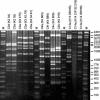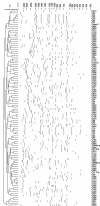Molecular serotyping of Klebsiella species isolates by restriction of the amplified capsular antigen gene cluster
- PMID: 15297473
- PMCID: PMC497587
- DOI: 10.1128/JCM.42.8.3388-3398.2004
Molecular serotyping of Klebsiella species isolates by restriction of the amplified capsular antigen gene cluster
Abstract
The objective of the present work was to develop a molecular method that would enable determination of the capsular serotypes of Klebsiella isolates without the use of antiserum. PCR amplification of the capsular antigen gene cluster (cps) was followed by digestion with the restriction enzyme HincII (cps PCR-restriction fragment length polymorphism [RFLP] analysis). The profiles (C patterns) obtained for 224 strains representing the 77 known K serotypes showed 3 to 13 fragments ranging in size from 0.2 to 4.4 kb. A total of 97 distinct C patterns were obtained; 100% of 61 pairs of samples tested twice showed reproducible C patterns. The C patterns were K-type specific; i.e., the C pattern(s) of any K serotype was distinct from the C patterns of all other K serotypes, with the only exceptions being serotypes K22 and K37, which are known to cross-react. For 12 of 17 K types for which at least two strains were included, C-pattern variations were found among strains with the same K serotype. Therefore, cps PCR-RFLP analysis has a higher discriminatory power than classical K serotyping. C-pattern identity was observed among strains with a given K type that were collected many years apart and from distinct sources, indicating C-pattern stability. Only 4.5% of the strains were nontypeable, because of unsuccessful PCR amplification (whereas 8 to 23% are nontypeable by classical K serotyping). Three of four noncapsulated strains analyzed showed recognizable C patterns. The K serotypes of 18 (82%) of 22 recent Klebsiella pneumoniae clinical isolates could be deduced from their C patterns. In conclusion, cps PCR-RFLP analysis allows determination of the K serotype, while it is easier to perform and more discriminatory than classical serotyping.
Figures



References
-
- Bingen, E. H., P. Desjardins, G. Arlet, F. Bourgeois, P. Mariani-Kurkdjian, N. Y. Lambert-Zechovsky, E. Denamur, A. Philippon, and J. Elion. 1993. Molecular epidemiology of plasmid spread among extended broad-spectrum beta-lactamase-producing Klebsiella pneumoniae isolates in a pediatric hospital. J. Clin. Microbiol. 31:179-184. - PMC - PubMed
-
- Brisse, S., D. Milatovic, A. C. Fluit, J. Verhoef, and F. J. Schmitz. 2000. Epidemiology of quinolone resistance of Klebsiella pneumoniae and Klebsiella oxytoca in Europe. Eur. J. Clin. Microbiol. Infect. Dis. 19:64-68. - PubMed
MeSH terms
LinkOut - more resources
Full Text Sources
Molecular Biology Databases
Research Materials

